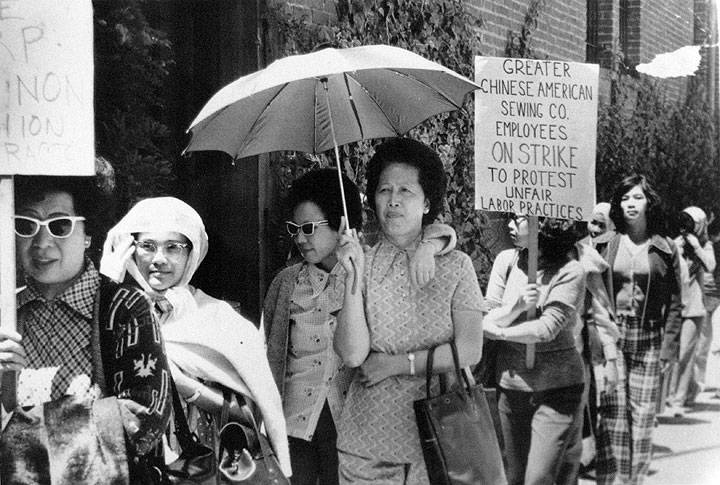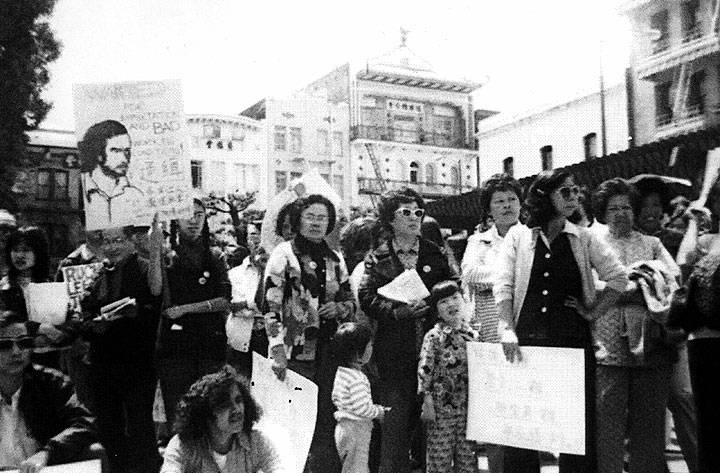Jung Sai Garment Workers Strike 1974: Difference between revisions
mNo edit summary |
m (added new photo) |
||
| Line 18: | Line 18: | ||
Impressed by the resoluteness of 135 striking Chinatown garment workers, the ''Chinese Times'' wrote an editorial in its July 27, 1974, issue entitled “Chinese Women Workers of the Great Chinese American Sewing Factory Demonstrate Against Exploitation.” The editorial stated, “Unexpectedly, these once subservient ''che yi ah shen ah mu'' (sewing factory aunties), once considered ''ru gao yang zhi fu'' (as subservient goats and sheep) are demanding their rights. They have been shouting, clapping, shouldering picket signs and demonstrating against the exploiting class. This is a ''shi po tian jing'' (earth-shattering and heaven-startling) event and has created a new page in Chinatown history.” | Impressed by the resoluteness of 135 striking Chinatown garment workers, the ''Chinese Times'' wrote an editorial in its July 27, 1974, issue entitled “Chinese Women Workers of the Great Chinese American Sewing Factory Demonstrate Against Exploitation.” The editorial stated, “Unexpectedly, these once subservient ''che yi ah shen ah mu'' (sewing factory aunties), once considered ''ru gao yang zhi fu'' (as subservient goats and sheep) are demanding their rights. They have been shouting, clapping, shouldering picket signs and demonstrating against the exploiting class. This is a ''shi po tian jing'' (earth-shattering and heaven-startling) event and has created a new page in Chinatown history.” | ||
[[Image:Jung-Sai- | [[Image:Jung-Sai-Garment-Strike-by-Cathy-Cade-1974 7129.jpg]] | ||
''' | '''Jung Sai garment factory workers picket line, 1974.''' | ||
''Photo: | ''Photo: Cathy Cade, Union WAGE collection, Labor Archives and Research Center, San Francisco State University'' | ||
Labor disputes involving less than several hundred workers are often discounted as insignificant. But the influence and effect of this dispute far outweighed its numbers. The 1974 Jung Sai garment workers strike began with widespread public support encompassing almost a year of strike activities, sixty-four arrests, and court injunctions. This united body of immigrant workers inspired popular support from community, student, and working-class populations throughout the San Francisco Bay area. The 135 strikers were mainly Chinese immigrant women with two men. Their interaction with hundreds of Asian-American activists and supporters became an important turning point for Asian-American activism in the San Francisco Bay Area. The strike encouraged further immigrant activism, energizing a grassroots movement among Chinese immigrant workers facing similar unfair labor practices. | Labor disputes involving less than several hundred workers are often discounted as insignificant. But the influence and effect of this dispute far outweighed its numbers. The 1974 Jung Sai garment workers strike began with widespread public support encompassing almost a year of strike activities, sixty-four arrests, and court injunctions. This united body of immigrant workers inspired popular support from community, student, and working-class populations throughout the San Francisco Bay area. The 135 strikers were mainly Chinese immigrant women with two men. Their interaction with hundreds of Asian-American activists and supporters became an important turning point for Asian-American activism in the San Francisco Bay Area. The strike encouraged further immigrant activism, energizing a grassroots movement among Chinese immigrant workers facing similar unfair labor practices. | ||
Located at 646 Washington Street in San Francisco, the Jung Sai factory was a large Chinatown plant owned by Esprit de Corps, a manufacturer and designer of contemporary clothing for young people. In Cantonese, Jung means Chinese and Sai means West but the factory name was translated in English as “Great Chinese American” (GCA). The combination of the two characters, Jung and Sai, projected a meaning of symbiotic cooperation between the Chinese employees and Western management. But to the workers, the term “Jung Sai” represented harassment, intimidation, speed-ups, lack of breaks, and low wages. To the women, “Jung Sai” was a metaphor for the one-sided power of Western manufacturers over Chinese immigrant labor—an imbalance that had to change. | Located at 646 Washington Street in San Francisco, the Jung Sai factory was a large Chinatown plant owned by Esprit de Corps, a manufacturer and designer of contemporary clothing for young people. In Cantonese, Jung means Chinese and Sai means West but the factory name was translated in English as “Great Chinese American” (GCA). The combination of the two characters, Jung and Sai, projected a meaning of symbiotic cooperation between the Chinese employees and Western management. But to the workers, the term “Jung Sai” represented harassment, intimidation, speed-ups, lack of breaks, and low wages. To the women, “Jung Sai” was a metaphor for the one-sided power of Western manufacturers over Chinese immigrant labor—an imbalance that had to change. | ||
[[Image:Jung-Sai-strikers-at-Portsmouth-square.jpg]] | |||
'''135 strikers from the Chinatown Jung Sai garment factory rallied at Portsmouth Square in 1974.''' | |||
''Photo: Asian Community Center Archive Group'' | |||
The workers’ subsequent strike redefined that relationship. Whenever Jung Sai was mentioned after 1974, community residents associated the words with workers’ resistance. What began as a single-issue unionization strike in one factory evolved into a multi-faceted campaign against exploitation and oppression of Chinese immigrants. | The workers’ subsequent strike redefined that relationship. Whenever Jung Sai was mentioned after 1974, community residents associated the words with workers’ resistance. What began as a single-issue unionization strike in one factory evolved into a multi-faceted campaign against exploitation and oppression of Chinese immigrants. | ||
Revision as of 14:39, 4 July 2012
Historical Essay
by Harvey Dong
Listen to an excerpt from "Jung Sai Garment Workers Strike of 1974: 'An Earth-Shattering and Heaven-Startling Event'" read by author Harvey Dong:
<embed src="http://www.archive.org/flow/flowplayer.commercial-3.2.1.swf" type="application/x-shockwave-flash" width="640" height="26" allowfullscreen="true" allowscriptaccess="always" cachebusting="true" bgcolor="#000000" quality="high" flashvars="config={'key':'#$aa4baff94a9bdcafce8','playlist':[{'url':'07HarveyDong900MinnesotaMastered2.mp3','autoPlay':false}],'clip':{'autoPlay':true,'baseUrl':'http://www.archive.org/download/7TenYears--jungSaiGarmentWorkersStrike/'},'canvas':{'backgroundColor':'#000000','backgroundGradient':'none'},'plugins':{'audio':{'url':'http://www.archive.org/flow/flowplayer.audio-3.2.1-dev.swf'},'controls':{'playlist':false,'fullscreen':false,'height':26,'backgroundColor':'#000000','autoHide':{'fullscreenOnly':true},'scrubberHeightRatio':0.6,'timeFontSize':9,'mute':false,'top':0}},'contextMenu':[{},'-','Flowplayer v3.2.1']}"> </embed>
by mp3.
![]()
Previous stop: People's Food System
Next Stop #8: GI resistance to Vietnam
Impressed by the resoluteness of 135 striking Chinatown garment workers, the Chinese Times wrote an editorial in its July 27, 1974, issue entitled “Chinese Women Workers of the Great Chinese American Sewing Factory Demonstrate Against Exploitation.” The editorial stated, “Unexpectedly, these once subservient che yi ah shen ah mu (sewing factory aunties), once considered ru gao yang zhi fu (as subservient goats and sheep) are demanding their rights. They have been shouting, clapping, shouldering picket signs and demonstrating against the exploiting class. This is a shi po tian jing (earth-shattering and heaven-startling) event and has created a new page in Chinatown history.”
Jung Sai garment factory workers picket line, 1974.
Photo: Cathy Cade, Union WAGE collection, Labor Archives and Research Center, San Francisco State University
Labor disputes involving less than several hundred workers are often discounted as insignificant. But the influence and effect of this dispute far outweighed its numbers. The 1974 Jung Sai garment workers strike began with widespread public support encompassing almost a year of strike activities, sixty-four arrests, and court injunctions. This united body of immigrant workers inspired popular support from community, student, and working-class populations throughout the San Francisco Bay area. The 135 strikers were mainly Chinese immigrant women with two men. Their interaction with hundreds of Asian-American activists and supporters became an important turning point for Asian-American activism in the San Francisco Bay Area. The strike encouraged further immigrant activism, energizing a grassroots movement among Chinese immigrant workers facing similar unfair labor practices.
Located at 646 Washington Street in San Francisco, the Jung Sai factory was a large Chinatown plant owned by Esprit de Corps, a manufacturer and designer of contemporary clothing for young people. In Cantonese, Jung means Chinese and Sai means West but the factory name was translated in English as “Great Chinese American” (GCA). The combination of the two characters, Jung and Sai, projected a meaning of symbiotic cooperation between the Chinese employees and Western management. But to the workers, the term “Jung Sai” represented harassment, intimidation, speed-ups, lack of breaks, and low wages. To the women, “Jung Sai” was a metaphor for the one-sided power of Western manufacturers over Chinese immigrant labor—an imbalance that had to change.
135 strikers from the Chinatown Jung Sai garment factory rallied at Portsmouth Square in 1974.
Photo: Asian Community Center Archive Group
The workers’ subsequent strike redefined that relationship. Whenever Jung Sai was mentioned after 1974, community residents associated the words with workers’ resistance. What began as a single-issue unionization strike in one factory evolved into a multi-faceted campaign against exploitation and oppression of Chinese immigrants.
by Harvey Dong, from his essay "Jung Sai Garment Workers Strike of 1974: 'An Earth-Shattering and Heaven-Startling Event'" in the anthology "Ten Years That Shook the City: San Francisco 1968-78" (City Lights Foundation: 2011), edited by Chris Carlsson.
 Find the book at City Lights!
Find the book at City Lights!



